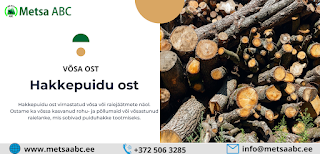Types, Pros & Cons of Clear-Cutting | metsaABC
Clear-cutting is a controversial forestry or forest management practice. Clear-cutting can have negative consequences on land and ecology. However, there are certain advantages as well. Although forest clear-cutting is sometimes used interchangeably with deforestation, the two are not always synonymous. In the most extreme circumstances, clear-cutting can result in land degradation, but it can also help with forest regeneration, which is one of the most important benefits of the activity. So, when used appropriately, it does have some beneficial impacts to consider.
What is clear-cutting?
Clear-cuts are forest-felling operations in which all or almost all of the trees in a certain region are felled at the same time. The approach is the most commercially appealing and, as a result, the most often used. Trees are frequently chopped in a regular manner. There are, however, alternative possibilities.
Clear-cutting is carried out for a variety of reasons, including wood harvesting and forest regeneration as part of a reforestation strategy. Because elderly trees are less resistant to viruses and illnesses, their removal is good for forest health. Furthermore, clear-cuts allow younger trees that do not tolerate shadow to receive more sunlight. As a result, saplings become mature stands.
Types of Forest Clear-cutting
There are several different clear-cutting techniques, each with its own set of trees to fell and cut area.
- Standard (uniform) logging - logging all trees in the region, regardless of commercial worth.
- Patching is the process of felling trees in a specific area (patches). The sale of felling waste is popular in forestry.
- Cutting trees in rows, usually at a right angle to the prevailing winds, is known as stripping.
- With reserves, certain trees are left for diverse uses, such as wildlife homes.
- Selection cutting (ecoforestry) necessitates the removal of particular trees for a variety of reasons (ecological, harvesting, forest health, etc.). Commercial logging typically entails removing the most valuable timber.
- Slash-and-burn forestry is the practice of cutting and burning forests for the purpose of agriculture or construction. Selling commercial timber, then burning the remaining stems and converting the land to farming, is a common method.
Pros and Cons of Clear-cutting
Depending on the context, the approach offers benefits and drawbacks. Although clear-cutting is not the sole method for harvesting merchantable timber, it is the most common. However, clear-negative cutting's consequences should not be overlooked.
Pros
- allows younger plants to get sunlight;
- increases the health of the forest;
- improves seeds and sprouting in species that don't tolerate shade;
- regenerates species that don't tolerate shade;
- wood that may be used for a variety of reasons;
- because the trees are chopped all at once, logging machinery causes less soil disturbance in the forest;
- reduce the chance of shallow-rooted trees being damaged by the wind;
- foresters benefit from this since it creates jobs and profits for them.
Cons
- Destroys forest ecosystems, denying species access to natural habitats and reducing biodiversity. Even yet, if the forest is replanted, animals may return to the region.
- Soil erosion becomes more likely. Clear-cutting causes erosion because trees slow down water currents and prevent the creation of rills.
- Directs to Sedimentation and nutrient leakage into bodies of water are the results.
- Intervenes the water cycle. Trees eat and release moisture through evapotranspiration, which interferes with the water cycle.
- Increase in water temperature due to riparian zones. Due to a lack of shade in riparian zones, the water temperature rises, causing aquatic species to suffer.
- Air quality deteriorates. Trees absorb carbon dioxide and fill the atmosphere with oxygen. This forest property is depleted through clear-cutting.
- Discard carbon sinks. Carbon is accumulated by trees and forest soil. Carbon is released into the atmosphere when forests are chopped down, contributing to global warming and climate change.
- The scenery is spoiled. Forest landscapes with bare spots appear desolate and unappealing.
- Slides are prompted. Tree roots keep the soil in place. The soil becomes loose after clear-cutting, resulting in sliding.
- Deforestation is a possibility. Forest losses, land destruction, and desertification might all arise from permanent forest cuts without regeneration.
During the first five to ten years before the saplings begin to participate in the water cycle, clear-cutting may cause water levels in nearby currents to rise. Even after deforestation, however, forest soil has greater soil absorption properties than agricultural soil.
How Long Does It Take A Forest To Recover Post Clear-Cut?
The average time for forest regeneration is thirty years. After five years, new seedlings develop, and by the age of fifteen, they have grown to be around 10 feet tall. At the age of thirty, they attain a height of 20 to 30 feet. The number of trees grows after clear-cutting: roughly a hundred mature trees are replaced by 300-500 offspring. Due to species competition, their density diminishes over time.
However, a much longer time is required for complete recovery (especially of rainforests). Tropical rainforests may regrow for up to 65 years, and animals play a critical role in seed dispersal (nearly 80 percent ).
Clear-cutting does not always imply forest devastation, and trees will not grow back. Clear-cutting has a number of advantages that make it a viable forest-generation strategy when paired with careful replanting planning. It's best if foresters use proper tree recovery methods, such as seeds, seedlings, or sprouts. After being cut down, tree trunks and branches can produce offspring.
MetsaABC is a forest management and harvesting company that provides all kinds of forest services for the private forest owners. Contact them today to know more about their forest services!


Kommentaarid
Postita kommentaar